APT6000: Trauma-Focused Counseling Interventions - Case Study
VerifiedAdded on 2023/06/10
|16
|3998
|275
Case Study
AI Summary
This case study delves into counseling interventions for individuals experiencing psychological trauma, particularly focusing on a fictional case named Sam. The study emphasizes the rationale behind early interventions, addresses treatment goals (both short-term and long-term), and outlines a structured treatment plan involving various psychological interventions such as Psychological Debriefing, PFA (Psychological First Aid) and CBT (Cognitive Behavioral Therapy). The interventions aim to address PTSD, promote emotional healing, and empower Sam to overcome her traumatic experiences of childhood sexual abuse. The study provides a comprehensive approach to trauma-informed counseling, highlighting the importance of creating a safe and supportive therapeutic environment for effective recovery.

Running Head: Advanced Counseling Interventions 1
Name
Institution
Date
Name
Institution
Date
Paraphrase This Document
Need a fresh take? Get an instant paraphrase of this document with our AI Paraphraser

Advanced Counseling Interventions 2
Rationale
Psychological trauma has been common and if it persists, it results into a PTSD. PTSD
should therefore be prevented to minimize the effects of individual and societal suffering. The
cause of PTSD is defined by a specific event that originates from a particular time and a specific
place. This means that the people exposed to psychological trauma can be picked and preventive
measures can be availed to them after being victims.
Despite calls that early interventions are less influential in preventing PTSD, or can lead
to more harm, they are widely employed to date. Employing this approach shows that uncertainty
and controversy is still common in the sector even though a good number of people still apply
these interventions with the hope of assisting an individual overcome traumatic state.
This study aims at reviewing the evidence both on the general and comparative impacts
and risk of using early interventions to treat PSTD in individuals under psychological traumatic
experiences. This report will further consider a case study of Sam, who has been sexually abused
since she was a lid until she recently opened up about the matter at the age of 21 (Koenig,
Boucher, Oliver, Youssef, Mooney, Currier, Pearce, 2017
Counseling
Most individuals have undergone a psychological traumatic experience of some type.
Following a traumatic experience, it can get difficult to understand what to do for other persons,
daily events can even be un-understandable and one may find it difficult to live a normal life.
Seeking professional assistance from a counselor is vital in overcoming such situations:
Rationale
Psychological trauma has been common and if it persists, it results into a PTSD. PTSD
should therefore be prevented to minimize the effects of individual and societal suffering. The
cause of PTSD is defined by a specific event that originates from a particular time and a specific
place. This means that the people exposed to psychological trauma can be picked and preventive
measures can be availed to them after being victims.
Despite calls that early interventions are less influential in preventing PTSD, or can lead
to more harm, they are widely employed to date. Employing this approach shows that uncertainty
and controversy is still common in the sector even though a good number of people still apply
these interventions with the hope of assisting an individual overcome traumatic state.
This study aims at reviewing the evidence both on the general and comparative impacts
and risk of using early interventions to treat PSTD in individuals under psychological traumatic
experiences. This report will further consider a case study of Sam, who has been sexually abused
since she was a lid until she recently opened up about the matter at the age of 21 (Koenig,
Boucher, Oliver, Youssef, Mooney, Currier, Pearce, 2017
Counseling
Most individuals have undergone a psychological traumatic experience of some type.
Following a traumatic experience, it can get difficult to understand what to do for other persons,
daily events can even be un-understandable and one may find it difficult to live a normal life.
Seeking professional assistance from a counselor is vital in overcoming such situations:
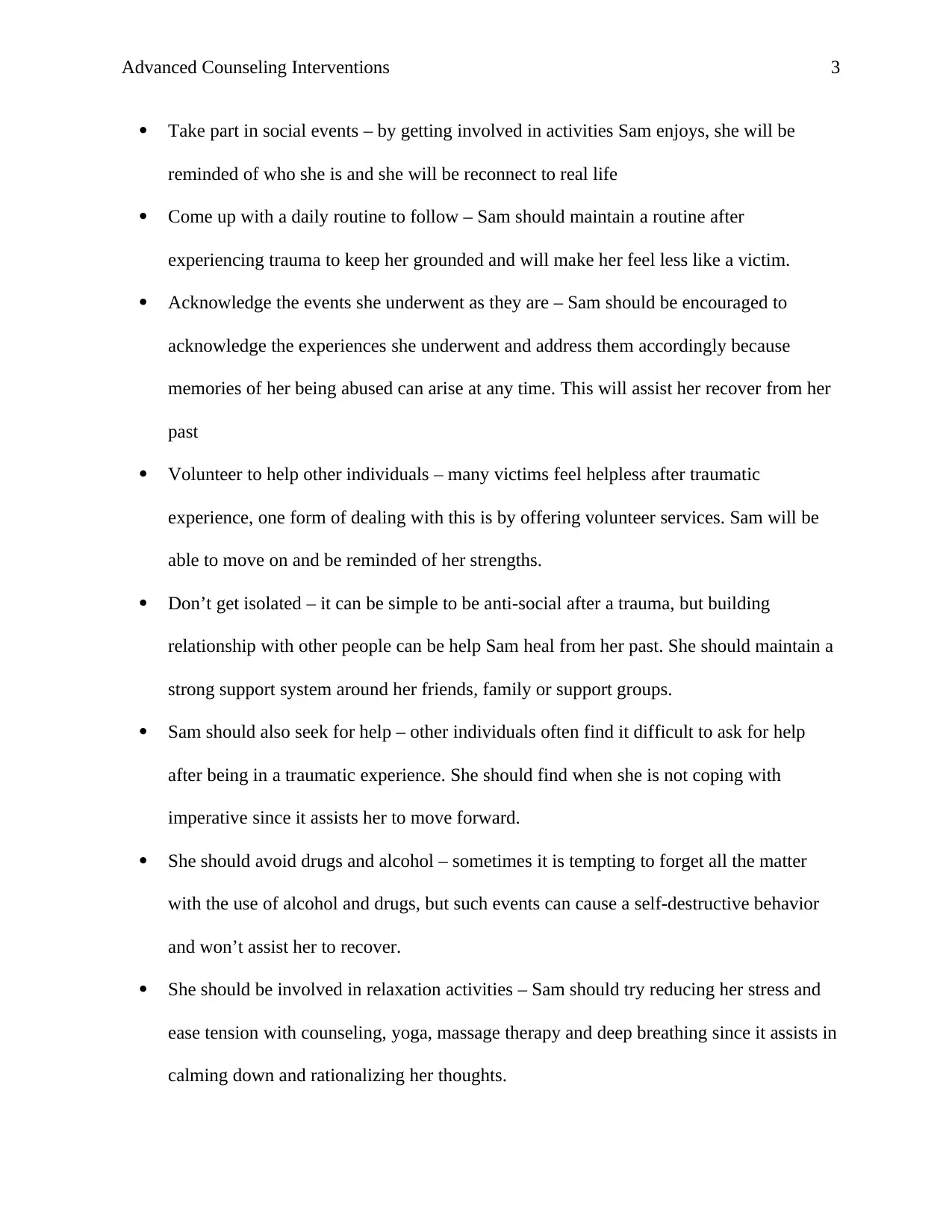
Advanced Counseling Interventions 3
Take part in social events – by getting involved in activities Sam enjoys, she will be
reminded of who she is and she will be reconnect to real life
Come up with a daily routine to follow – Sam should maintain a routine after
experiencing trauma to keep her grounded and will make her feel less like a victim.
Acknowledge the events she underwent as they are – Sam should be encouraged to
acknowledge the experiences she underwent and address them accordingly because
memories of her being abused can arise at any time. This will assist her recover from her
past
Volunteer to help other individuals – many victims feel helpless after traumatic
experience, one form of dealing with this is by offering volunteer services. Sam will be
able to move on and be reminded of her strengths.
Don’t get isolated – it can be simple to be anti-social after a trauma, but building
relationship with other people can be help Sam heal from her past. She should maintain a
strong support system around her friends, family or support groups.
Sam should also seek for help – other individuals often find it difficult to ask for help
after being in a traumatic experience. She should find when she is not coping with
imperative since it assists her to move forward.
She should avoid drugs and alcohol – sometimes it is tempting to forget all the matter
with the use of alcohol and drugs, but such events can cause a self-destructive behavior
and won’t assist her to recover.
She should be involved in relaxation activities – Sam should try reducing her stress and
ease tension with counseling, yoga, massage therapy and deep breathing since it assists in
calming down and rationalizing her thoughts.
Take part in social events – by getting involved in activities Sam enjoys, she will be
reminded of who she is and she will be reconnect to real life
Come up with a daily routine to follow – Sam should maintain a routine after
experiencing trauma to keep her grounded and will make her feel less like a victim.
Acknowledge the events she underwent as they are – Sam should be encouraged to
acknowledge the experiences she underwent and address them accordingly because
memories of her being abused can arise at any time. This will assist her recover from her
past
Volunteer to help other individuals – many victims feel helpless after traumatic
experience, one form of dealing with this is by offering volunteer services. Sam will be
able to move on and be reminded of her strengths.
Don’t get isolated – it can be simple to be anti-social after a trauma, but building
relationship with other people can be help Sam heal from her past. She should maintain a
strong support system around her friends, family or support groups.
Sam should also seek for help – other individuals often find it difficult to ask for help
after being in a traumatic experience. She should find when she is not coping with
imperative since it assists her to move forward.
She should avoid drugs and alcohol – sometimes it is tempting to forget all the matter
with the use of alcohol and drugs, but such events can cause a self-destructive behavior
and won’t assist her to recover.
She should be involved in relaxation activities – Sam should try reducing her stress and
ease tension with counseling, yoga, massage therapy and deep breathing since it assists in
calming down and rationalizing her thoughts.
⊘ This is a preview!⊘
Do you want full access?
Subscribe today to unlock all pages.

Trusted by 1+ million students worldwide
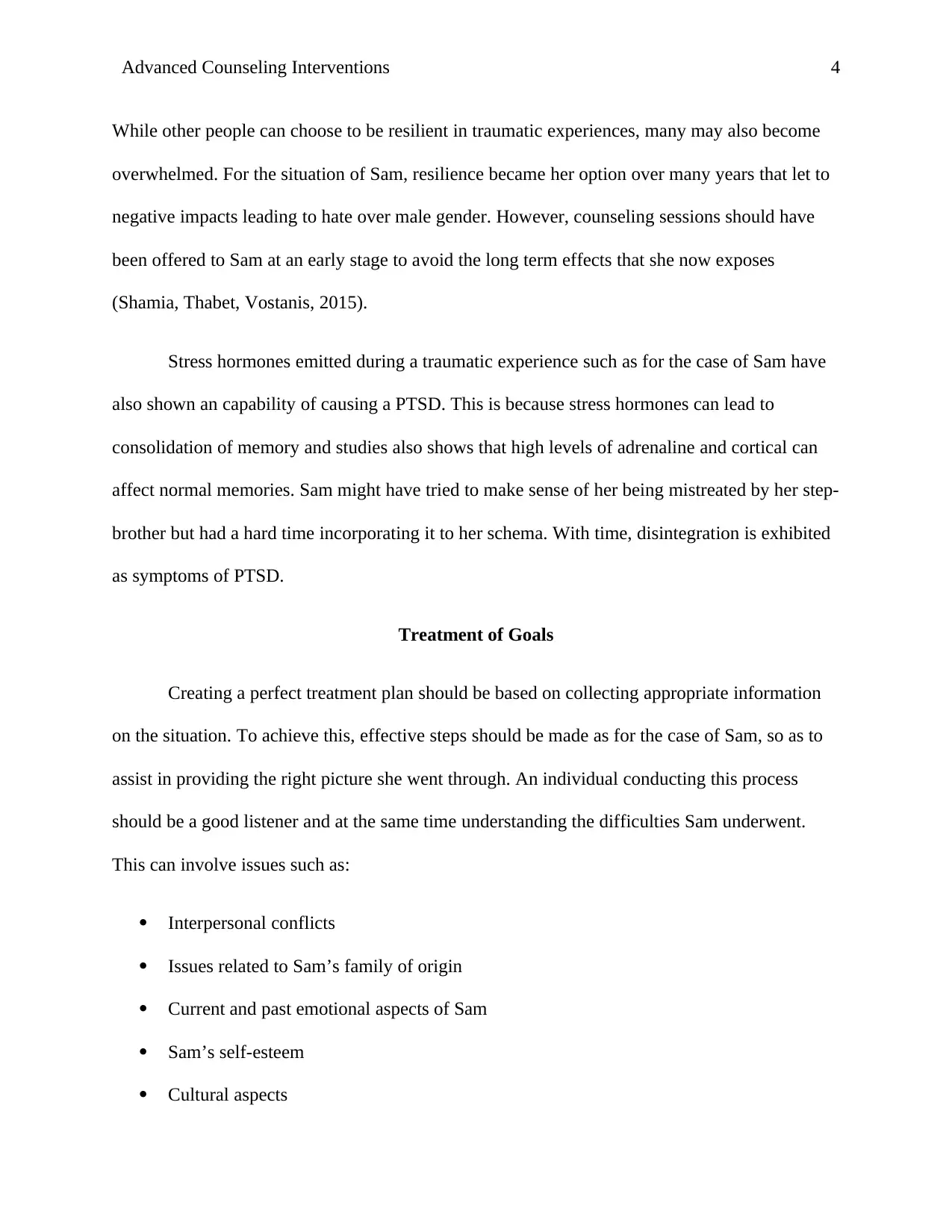
Advanced Counseling Interventions 4
While other people can choose to be resilient in traumatic experiences, many may also become
overwhelmed. For the situation of Sam, resilience became her option over many years that let to
negative impacts leading to hate over male gender. However, counseling sessions should have
been offered to Sam at an early stage to avoid the long term effects that she now exposes
(Shamia, Thabet, Vostanis, 2015).
Stress hormones emitted during a traumatic experience such as for the case of Sam have
also shown an capability of causing a PTSD. This is because stress hormones can lead to
consolidation of memory and studies also shows that high levels of adrenaline and cortical can
affect normal memories. Sam might have tried to make sense of her being mistreated by her step-
brother but had a hard time incorporating it to her schema. With time, disintegration is exhibited
as symptoms of PTSD.
Treatment of Goals
Creating a perfect treatment plan should be based on collecting appropriate information
on the situation. To achieve this, effective steps should be made as for the case of Sam, so as to
assist in providing the right picture she went through. An individual conducting this process
should be a good listener and at the same time understanding the difficulties Sam underwent.
This can involve issues such as:
Interpersonal conflicts
Issues related to Sam’s family of origin
Current and past emotional aspects of Sam
Sam’s self-esteem
Cultural aspects
While other people can choose to be resilient in traumatic experiences, many may also become
overwhelmed. For the situation of Sam, resilience became her option over many years that let to
negative impacts leading to hate over male gender. However, counseling sessions should have
been offered to Sam at an early stage to avoid the long term effects that she now exposes
(Shamia, Thabet, Vostanis, 2015).
Stress hormones emitted during a traumatic experience such as for the case of Sam have
also shown an capability of causing a PTSD. This is because stress hormones can lead to
consolidation of memory and studies also shows that high levels of adrenaline and cortical can
affect normal memories. Sam might have tried to make sense of her being mistreated by her step-
brother but had a hard time incorporating it to her schema. With time, disintegration is exhibited
as symptoms of PTSD.
Treatment of Goals
Creating a perfect treatment plan should be based on collecting appropriate information
on the situation. To achieve this, effective steps should be made as for the case of Sam, so as to
assist in providing the right picture she went through. An individual conducting this process
should be a good listener and at the same time understanding the difficulties Sam underwent.
This can involve issues such as:
Interpersonal conflicts
Issues related to Sam’s family of origin
Current and past emotional aspects of Sam
Sam’s self-esteem
Cultural aspects
Paraphrase This Document
Need a fresh take? Get an instant paraphrase of this document with our AI Paraphraser
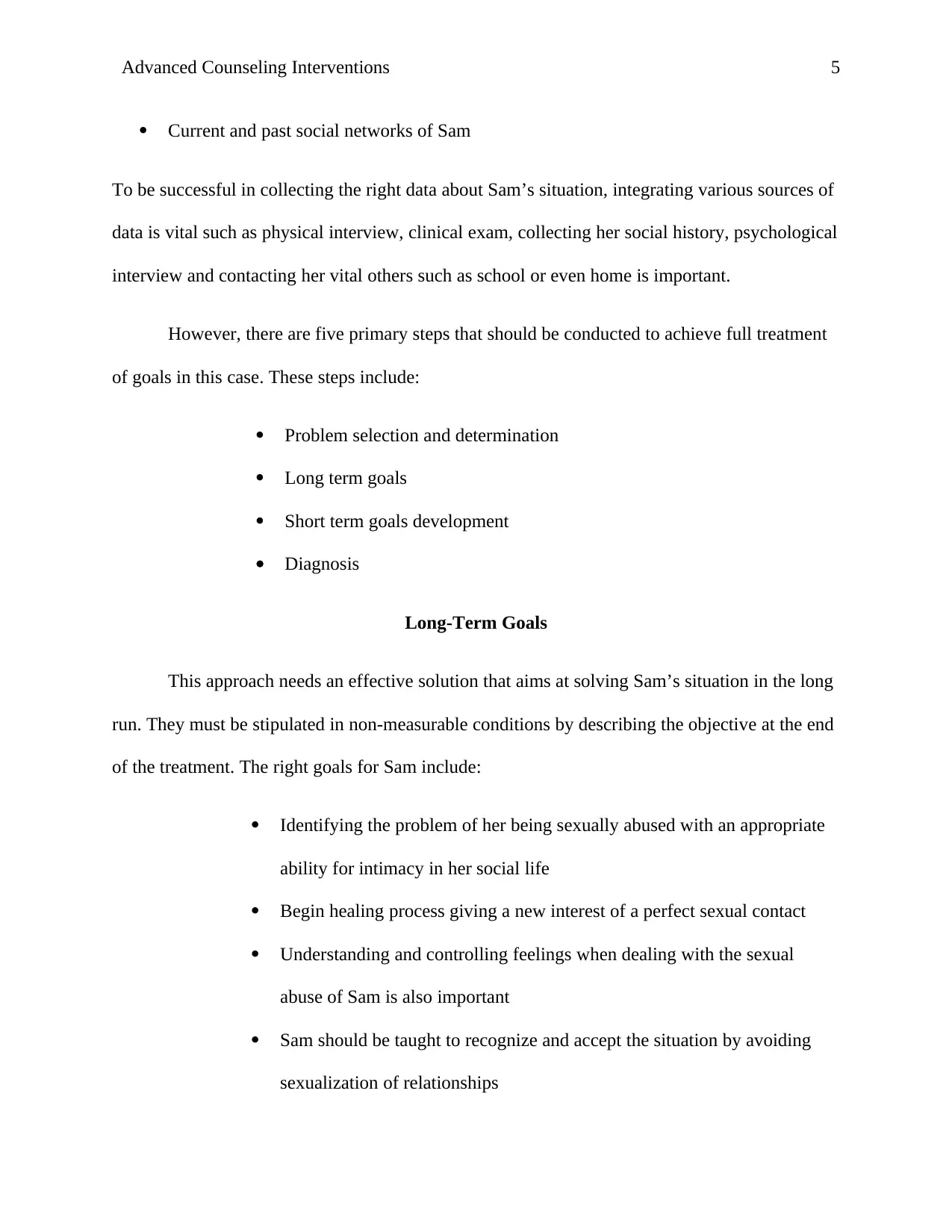
Advanced Counseling Interventions 5
Current and past social networks of Sam
To be successful in collecting the right data about Sam’s situation, integrating various sources of
data is vital such as physical interview, clinical exam, collecting her social history, psychological
interview and contacting her vital others such as school or even home is important.
However, there are five primary steps that should be conducted to achieve full treatment
of goals in this case. These steps include:
Problem selection and determination
Long term goals
Short term goals development
Diagnosis
Long-Term Goals
This approach needs an effective solution that aims at solving Sam’s situation in the long
run. They must be stipulated in non-measurable conditions by describing the objective at the end
of the treatment. The right goals for Sam include:
Identifying the problem of her being sexually abused with an appropriate
ability for intimacy in her social life
Begin healing process giving a new interest of a perfect sexual contact
Understanding and controlling feelings when dealing with the sexual
abuse of Sam is also important
Sam should be taught to recognize and accept the situation by avoiding
sexualization of relationships
Current and past social networks of Sam
To be successful in collecting the right data about Sam’s situation, integrating various sources of
data is vital such as physical interview, clinical exam, collecting her social history, psychological
interview and contacting her vital others such as school or even home is important.
However, there are five primary steps that should be conducted to achieve full treatment
of goals in this case. These steps include:
Problem selection and determination
Long term goals
Short term goals development
Diagnosis
Long-Term Goals
This approach needs an effective solution that aims at solving Sam’s situation in the long
run. They must be stipulated in non-measurable conditions by describing the objective at the end
of the treatment. The right goals for Sam include:
Identifying the problem of her being sexually abused with an appropriate
ability for intimacy in her social life
Begin healing process giving a new interest of a perfect sexual contact
Understanding and controlling feelings when dealing with the sexual
abuse of Sam is also important
Sam should be taught to recognize and accept the situation by avoiding
sexualization of relationships

Advanced Counseling Interventions 6
The sexual abuse should also be defined if it actually occurred
Finally, Sam should be taken as a survivor rather than a victim of sexual
abuse
Short-Term Goals
The short term goals that will be employed in treating Sam, should have a structure. This
helps in case short term goals are not achieved, new strategies are put in place to intervene the
situation. Strategies planned should be based on Sam’s needs and her presenting issue. Examples
of short term goals and its strategies include:
Intensifying the number of open talks with Sam about her feelings and
acceptance of the sexual abuse. She should be taken through several talks
to enable her open up without feeling ashamed by reminding her that she
had no role in the abuse but she was just exposed and she managed to
survive the ordeal.
Encourage Sam to disengage herself with shame and let her admit she had
not responsibility in the situation. Sam should be assisted to identify,
express and process all the guilt connected to her emotional satisfaction,
responsibility, physical pleasure linked to her situation. Sam should then
be empowered to be able heal from her issues and let the situation be her
testimony.
Psychological Interventions
The sexual abuse should also be defined if it actually occurred
Finally, Sam should be taken as a survivor rather than a victim of sexual
abuse
Short-Term Goals
The short term goals that will be employed in treating Sam, should have a structure. This
helps in case short term goals are not achieved, new strategies are put in place to intervene the
situation. Strategies planned should be based on Sam’s needs and her presenting issue. Examples
of short term goals and its strategies include:
Intensifying the number of open talks with Sam about her feelings and
acceptance of the sexual abuse. She should be taken through several talks
to enable her open up without feeling ashamed by reminding her that she
had no role in the abuse but she was just exposed and she managed to
survive the ordeal.
Encourage Sam to disengage herself with shame and let her admit she had
not responsibility in the situation. Sam should be assisted to identify,
express and process all the guilt connected to her emotional satisfaction,
responsibility, physical pleasure linked to her situation. Sam should then
be empowered to be able heal from her issues and let the situation be her
testimony.
Psychological Interventions
⊘ This is a preview!⊘
Do you want full access?
Subscribe today to unlock all pages.

Trusted by 1+ million students worldwide
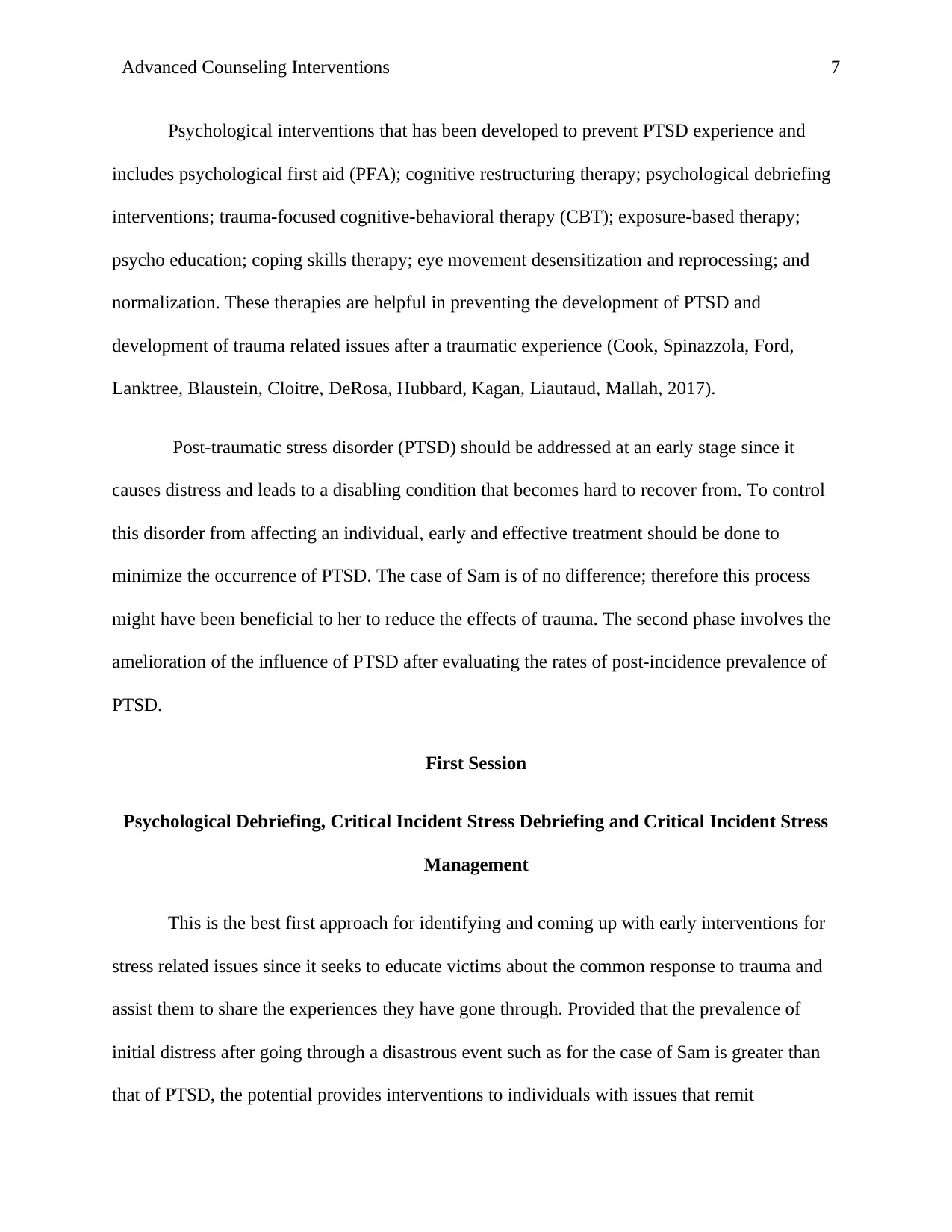
Advanced Counseling Interventions 7
Psychological interventions that has been developed to prevent PTSD experience and
includes psychological first aid (PFA); cognitive restructuring therapy; psychological debriefing
interventions; trauma-focused cognitive-behavioral therapy (CBT); exposure-based therapy;
psycho education; coping skills therapy; eye movement desensitization and reprocessing; and
normalization. These therapies are helpful in preventing the development of PTSD and
development of trauma related issues after a traumatic experience (Cook, Spinazzola, Ford,
Lanktree, Blaustein, Cloitre, DeRosa, Hubbard, Kagan, Liautaud, Mallah, 2017).
Post-traumatic stress disorder (PTSD) should be addressed at an early stage since it
causes distress and leads to a disabling condition that becomes hard to recover from. To control
this disorder from affecting an individual, early and effective treatment should be done to
minimize the occurrence of PTSD. The case of Sam is of no difference; therefore this process
might have been beneficial to her to reduce the effects of trauma. The second phase involves the
amelioration of the influence of PTSD after evaluating the rates of post-incidence prevalence of
PTSD.
First Session
Psychological Debriefing, Critical Incident Stress Debriefing and Critical Incident Stress
Management
This is the best first approach for identifying and coming up with early interventions for
stress related issues since it seeks to educate victims about the common response to trauma and
assist them to share the experiences they have gone through. Provided that the prevalence of
initial distress after going through a disastrous event such as for the case of Sam is greater than
that of PTSD, the potential provides interventions to individuals with issues that remit
Psychological interventions that has been developed to prevent PTSD experience and
includes psychological first aid (PFA); cognitive restructuring therapy; psychological debriefing
interventions; trauma-focused cognitive-behavioral therapy (CBT); exposure-based therapy;
psycho education; coping skills therapy; eye movement desensitization and reprocessing; and
normalization. These therapies are helpful in preventing the development of PTSD and
development of trauma related issues after a traumatic experience (Cook, Spinazzola, Ford,
Lanktree, Blaustein, Cloitre, DeRosa, Hubbard, Kagan, Liautaud, Mallah, 2017).
Post-traumatic stress disorder (PTSD) should be addressed at an early stage since it
causes distress and leads to a disabling condition that becomes hard to recover from. To control
this disorder from affecting an individual, early and effective treatment should be done to
minimize the occurrence of PTSD. The case of Sam is of no difference; therefore this process
might have been beneficial to her to reduce the effects of trauma. The second phase involves the
amelioration of the influence of PTSD after evaluating the rates of post-incidence prevalence of
PTSD.
First Session
Psychological Debriefing, Critical Incident Stress Debriefing and Critical Incident Stress
Management
This is the best first approach for identifying and coming up with early interventions for
stress related issues since it seeks to educate victims about the common response to trauma and
assist them to share the experiences they have gone through. Provided that the prevalence of
initial distress after going through a disastrous event such as for the case of Sam is greater than
that of PTSD, the potential provides interventions to individuals with issues that remit
Paraphrase This Document
Need a fresh take? Get an instant paraphrase of this document with our AI Paraphraser

Advanced Counseling Interventions 8
impetuously. Early interventions for Sam should have involved confronting approaches of
distressing process. Debriefing and critical incident stress debriefing (CISD) should have been
applied as early intervention for Sam. This session assists in addressing the immediate
psychological aftermath of such trauma. CISD can be stated as a meeting of those affected by
traumatic event such as for Sam that focus to minimize the effects of the situation by enhancing
support and encouraging processing the experience of the abuses she had been exposed to.
Critical incident stress management (CISM) is also another approach that Sam should have been
taken through since it involves a stand-alone debriefing engagement that provide various
components such as pre-trauma training, a follow-up and case management. Both approaches
above should have been employed to speed the recovery process before Sam was exposed to
harmful stress response that can affect the performance of Sam. However, these approaches do
not guarantee to deliver early interventions or even cut the effects of PTSD. A single session has
also been dubbed to be fruitless at times or even cause more harm to those debriefed (Currier,
Holland, Drescher, 2015).
Second Session
PFA is a systematic set of assisting approach focused on minimizing the initial post-
trauma distress and enhancing short and long term adaptive functioning. PFA is developed as an
initial process of comprehensive disaster and it is designed around eight core actions. These are:
Stabilization
Information gathering
Contact and engagement
Information
impetuously. Early interventions for Sam should have involved confronting approaches of
distressing process. Debriefing and critical incident stress debriefing (CISD) should have been
applied as early intervention for Sam. This session assists in addressing the immediate
psychological aftermath of such trauma. CISD can be stated as a meeting of those affected by
traumatic event such as for Sam that focus to minimize the effects of the situation by enhancing
support and encouraging processing the experience of the abuses she had been exposed to.
Critical incident stress management (CISM) is also another approach that Sam should have been
taken through since it involves a stand-alone debriefing engagement that provide various
components such as pre-trauma training, a follow-up and case management. Both approaches
above should have been employed to speed the recovery process before Sam was exposed to
harmful stress response that can affect the performance of Sam. However, these approaches do
not guarantee to deliver early interventions or even cut the effects of PTSD. A single session has
also been dubbed to be fruitless at times or even cause more harm to those debriefed (Currier,
Holland, Drescher, 2015).
Second Session
PFA is a systematic set of assisting approach focused on minimizing the initial post-
trauma distress and enhancing short and long term adaptive functioning. PFA is developed as an
initial process of comprehensive disaster and it is designed around eight core actions. These are:
Stabilization
Information gathering
Contact and engagement
Information

Advanced Counseling Interventions 9
Safety and comfort
Practical assistance
Connection with social supports
Information on coping support
Linkage with collaborative
PFA concept enhanced and its use needs assessment and clinical approach provides the
complexity of presentations, need, variability of context, and logical constraints. PFA is usually
applied by counselors and mental health responders. Two key advantages of PFA is its
portability and can be offered in any place. This approach fits Sam since it can be delivered at
her home. However, Sam was collaborative in this session since she was able to open up.
Therefore, her response was positive that led to the next session (Burgdorf, Kroes, Zhang, Gross,
Schmidt, Weiss, Disterhoft, Burch, Stanton, Moskal, 2015).
Third Session
CBT is another important session that should have been employed to help Sam heal from
her traumatic experience. This principle involves learning and conditioning to heal disorders and
it applies components from cognitive and behavioral therapy. This approach could have help
Sam in cognitive restructuring, exposure, and several coping experiences that can also be
combined together to bring out the best results. Sam should have been needed to attend a weekly
session that goes for 60-90 minutes either as individual or as a group (Meichenbaum, 2017)..
Exposure-based therapy use confrontation with agitating stimuli and is applied regularly
until anxiety is minimized. The exposure is used according to mental imagery from memory or
employed series provided by therapist. For Sam, this session is vital for doing away with
emotional response to traumatic stimuli. Sam will therefore be able to reduce the effects caused
Safety and comfort
Practical assistance
Connection with social supports
Information on coping support
Linkage with collaborative
PFA concept enhanced and its use needs assessment and clinical approach provides the
complexity of presentations, need, variability of context, and logical constraints. PFA is usually
applied by counselors and mental health responders. Two key advantages of PFA is its
portability and can be offered in any place. This approach fits Sam since it can be delivered at
her home. However, Sam was collaborative in this session since she was able to open up.
Therefore, her response was positive that led to the next session (Burgdorf, Kroes, Zhang, Gross,
Schmidt, Weiss, Disterhoft, Burch, Stanton, Moskal, 2015).
Third Session
CBT is another important session that should have been employed to help Sam heal from
her traumatic experience. This principle involves learning and conditioning to heal disorders and
it applies components from cognitive and behavioral therapy. This approach could have help
Sam in cognitive restructuring, exposure, and several coping experiences that can also be
combined together to bring out the best results. Sam should have been needed to attend a weekly
session that goes for 60-90 minutes either as individual or as a group (Meichenbaum, 2017)..
Exposure-based therapy use confrontation with agitating stimuli and is applied regularly
until anxiety is minimized. The exposure is used according to mental imagery from memory or
employed series provided by therapist. For Sam, this session is vital for doing away with
emotional response to traumatic stimuli. Sam will therefore be able to reduce the effects caused
⊘ This is a preview!⊘
Do you want full access?
Subscribe today to unlock all pages.

Trusted by 1+ million students worldwide
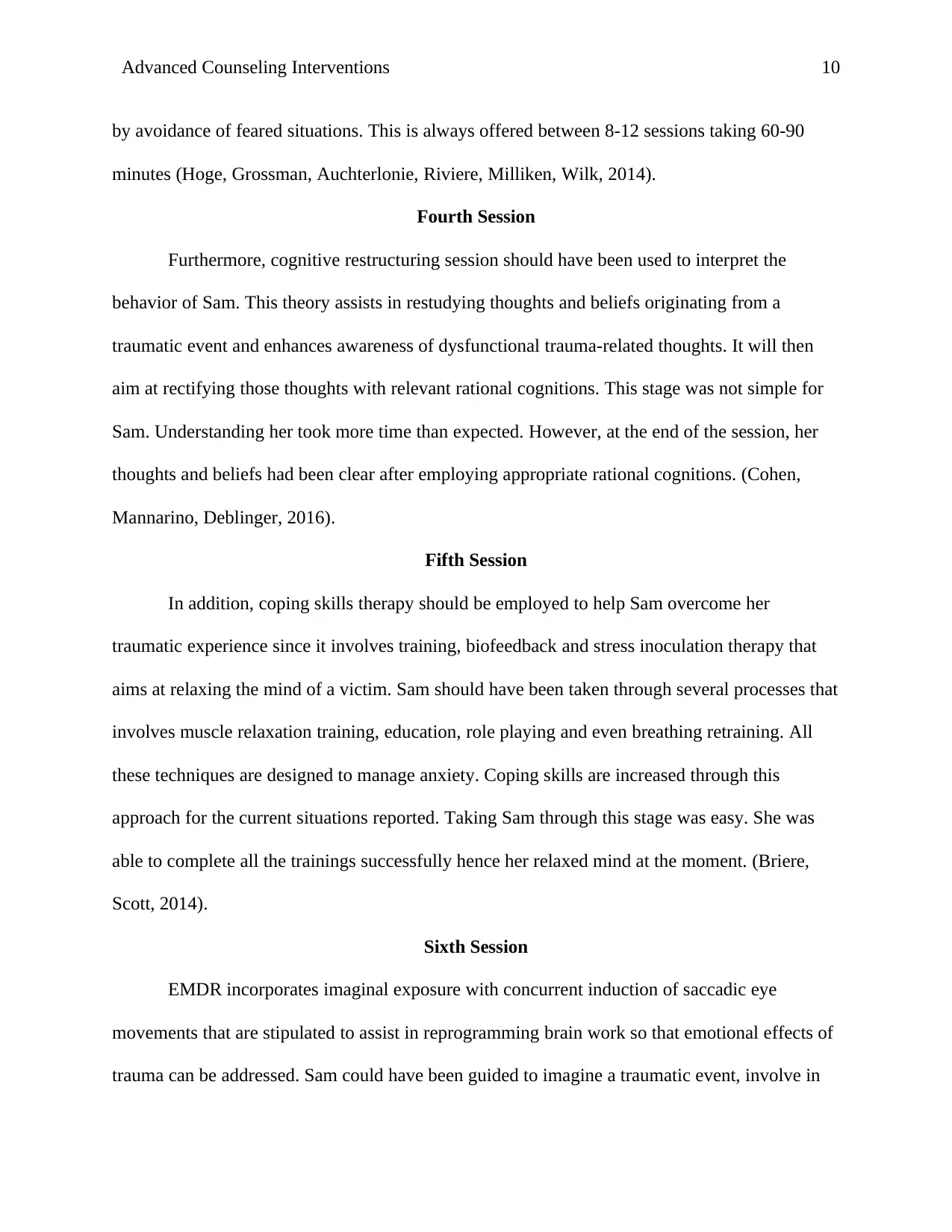
Advanced Counseling Interventions 10
by avoidance of feared situations. This is always offered between 8-12 sessions taking 60-90
minutes (Hoge, Grossman, Auchterlonie, Riviere, Milliken, Wilk, 2014).
Fourth Session
Furthermore, cognitive restructuring session should have been used to interpret the
behavior of Sam. This theory assists in restudying thoughts and beliefs originating from a
traumatic event and enhances awareness of dysfunctional trauma-related thoughts. It will then
aim at rectifying those thoughts with relevant rational cognitions. This stage was not simple for
Sam. Understanding her took more time than expected. However, at the end of the session, her
thoughts and beliefs had been clear after employing appropriate rational cognitions. (Cohen,
Mannarino, Deblinger, 2016).
Fifth Session
In addition, coping skills therapy should be employed to help Sam overcome her
traumatic experience since it involves training, biofeedback and stress inoculation therapy that
aims at relaxing the mind of a victim. Sam should have been taken through several processes that
involves muscle relaxation training, education, role playing and even breathing retraining. All
these techniques are designed to manage anxiety. Coping skills are increased through this
approach for the current situations reported. Taking Sam through this stage was easy. She was
able to complete all the trainings successfully hence her relaxed mind at the moment. (Briere,
Scott, 2014).
Sixth Session
EMDR incorporates imaginal exposure with concurrent induction of saccadic eye
movements that are stipulated to assist in reprogramming brain work so that emotional effects of
trauma can be addressed. Sam could have been guided to imagine a traumatic event, involve in
by avoidance of feared situations. This is always offered between 8-12 sessions taking 60-90
minutes (Hoge, Grossman, Auchterlonie, Riviere, Milliken, Wilk, 2014).
Fourth Session
Furthermore, cognitive restructuring session should have been used to interpret the
behavior of Sam. This theory assists in restudying thoughts and beliefs originating from a
traumatic event and enhances awareness of dysfunctional trauma-related thoughts. It will then
aim at rectifying those thoughts with relevant rational cognitions. This stage was not simple for
Sam. Understanding her took more time than expected. However, at the end of the session, her
thoughts and beliefs had been clear after employing appropriate rational cognitions. (Cohen,
Mannarino, Deblinger, 2016).
Fifth Session
In addition, coping skills therapy should be employed to help Sam overcome her
traumatic experience since it involves training, biofeedback and stress inoculation therapy that
aims at relaxing the mind of a victim. Sam should have been taken through several processes that
involves muscle relaxation training, education, role playing and even breathing retraining. All
these techniques are designed to manage anxiety. Coping skills are increased through this
approach for the current situations reported. Taking Sam through this stage was easy. She was
able to complete all the trainings successfully hence her relaxed mind at the moment. (Briere,
Scott, 2014).
Sixth Session
EMDR incorporates imaginal exposure with concurrent induction of saccadic eye
movements that are stipulated to assist in reprogramming brain work so that emotional effects of
trauma can be addressed. Sam could have been guided to imagine a traumatic event, involve in
Paraphrase This Document
Need a fresh take? Get an instant paraphrase of this document with our AI Paraphraser

Advanced Counseling Interventions 11
negative cognition, and then express a conflicting positive cognition. Clinician will ask Sam to
think of a memory while the clinician aims at the swift movement of the clinician’s fingers. After
making over 10 movements back and forth, the clinician question Sam to give a rating of the
memory and her belief in positive cognition. Even though earlier versions of EMDR were
conducted in1 to 3 sessions, the latest standards takes place for 8 to 12 weekly sessions with 90
minutes each. The response from Sam was positive. Even though she had a hard time focusing at
the beginning, she completed this session with a positive cognition (Briere, Scott, 2014).
There are three phases of treating trauma that involves safety, process and examining.
Seek Safety
This first step will seek to address traumatic conditions is to create safety on different
levels. Sam should find a place to ground herself and feel safe from harm. She should then find a
method to nurture herself. She should look for people in her life that can give her support, love,
understanding and care. Family and friends should be the closest people to help Sam recover
from her state. Furthermore there are organizations that can also assist, support and serve her
also (Schimmenti, Passanisi, Caretti, Marca, Granieri, Iacolino, Gervasi, Maganuco, Billieux,
2017).
Process
After feeling grounded, contained and safe, Sam should start to process the stages of
experience that are still with her. She should look at her body and pick an appropriate movement
that will assist her to relate better with herself and her feelings. A good therapist or group should
be consulted so that Sam can open up and be honest. And as she will keep on with the process
she will come up with coping skills and strengths based on safety and containments she will
develop.
negative cognition, and then express a conflicting positive cognition. Clinician will ask Sam to
think of a memory while the clinician aims at the swift movement of the clinician’s fingers. After
making over 10 movements back and forth, the clinician question Sam to give a rating of the
memory and her belief in positive cognition. Even though earlier versions of EMDR were
conducted in1 to 3 sessions, the latest standards takes place for 8 to 12 weekly sessions with 90
minutes each. The response from Sam was positive. Even though she had a hard time focusing at
the beginning, she completed this session with a positive cognition (Briere, Scott, 2014).
There are three phases of treating trauma that involves safety, process and examining.
Seek Safety
This first step will seek to address traumatic conditions is to create safety on different
levels. Sam should find a place to ground herself and feel safe from harm. She should then find a
method to nurture herself. She should look for people in her life that can give her support, love,
understanding and care. Family and friends should be the closest people to help Sam recover
from her state. Furthermore there are organizations that can also assist, support and serve her
also (Schimmenti, Passanisi, Caretti, Marca, Granieri, Iacolino, Gervasi, Maganuco, Billieux,
2017).
Process
After feeling grounded, contained and safe, Sam should start to process the stages of
experience that are still with her. She should look at her body and pick an appropriate movement
that will assist her to relate better with herself and her feelings. A good therapist or group should
be consulted so that Sam can open up and be honest. And as she will keep on with the process
she will come up with coping skills and strengths based on safety and containments she will
develop.

Advanced Counseling Interventions 12
Examine
After process approach is complete, life should move on. The aim is to keep in mind the
traumatic experience that Sam went through but respond to emotional charge she has in the
present. She can decide to reflect on any lesson learnt from such experience. What insights have
she developed? She can even decide to make herself a note of the positive things she have
learned (Treanor, Brown, Rissman, Craske, 2017).
Conclusion
There are several reasons why early interventions can be less influential:
PTSD involves a difficult etiology
It is hard to find which individual is exposed to continuous issues.
Early responses to trauma always shift and applies both normal and abnormal
behavior
Dealing with disastrous events in early stage is also complex.
The contribution provided by early intervention is always unnoticeable.
The most effective sessions of CBT are those that takes weeks after trauma. In most
cases, if the victim cannot tolerate CBT, the best option is to apply supportive counselling since
it offers lower intensity of some components of brief CBT
In early stages, effective treatment should be applied to symptomatic survivors.
The following process should be followed in response to traumatic events:
1. Avail concrete help, shelter and even food.
2. The next stage involves soothing to reduce extreme emotion and improve
controllability.
Examine
After process approach is complete, life should move on. The aim is to keep in mind the
traumatic experience that Sam went through but respond to emotional charge she has in the
present. She can decide to reflect on any lesson learnt from such experience. What insights have
she developed? She can even decide to make herself a note of the positive things she have
learned (Treanor, Brown, Rissman, Craske, 2017).
Conclusion
There are several reasons why early interventions can be less influential:
PTSD involves a difficult etiology
It is hard to find which individual is exposed to continuous issues.
Early responses to trauma always shift and applies both normal and abnormal
behavior
Dealing with disastrous events in early stage is also complex.
The contribution provided by early intervention is always unnoticeable.
The most effective sessions of CBT are those that takes weeks after trauma. In most
cases, if the victim cannot tolerate CBT, the best option is to apply supportive counselling since
it offers lower intensity of some components of brief CBT
In early stages, effective treatment should be applied to symptomatic survivors.
The following process should be followed in response to traumatic events:
1. Avail concrete help, shelter and even food.
2. The next stage involves soothing to reduce extreme emotion and improve
controllability.
⊘ This is a preview!⊘
Do you want full access?
Subscribe today to unlock all pages.

Trusted by 1+ million students worldwide
1 out of 16
Related Documents
Your All-in-One AI-Powered Toolkit for Academic Success.
+13062052269
info@desklib.com
Available 24*7 on WhatsApp / Email
![[object Object]](/_next/static/media/star-bottom.7253800d.svg)
Unlock your academic potential
Copyright © 2020–2025 A2Z Services. All Rights Reserved. Developed and managed by ZUCOL.




